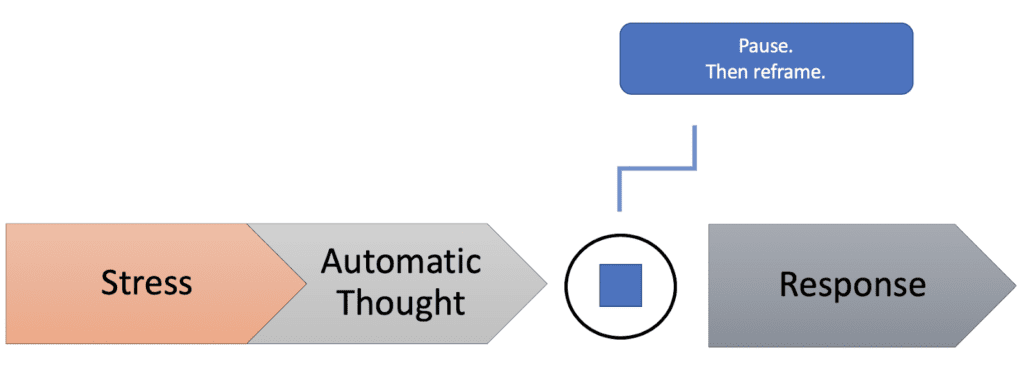Can DiSC help with stress?
The DiSC® model has helped millions of people know themselves better. It helps us understand our underlying thoughts and motivations, and it can also help you navigate stress and anxiety. The Everything DiSC Workplace® report can help you unpack your internal stressors as well as deepen your understanding of the best way to approach and support those around you.
Of course, it’s important to remember that human beings are complex. DiSC can’t tell you everything you might want to know about yourself or someone else’s response to stress, but it can help start the conversation. When navigating stress with others, you will need to know that person’s DiSC style. Locate and review their style section on pages 17-20 of the Everything DiSC Workplace report (Personalized Style Index). Before you you talk with them ask the following:
- What do people with this DiSC style fear?
- How do they react under pressure?
- What tactics under the “Overuses” section have you seen them rely on under stress?
Pick out some good talking points from this section to kickstart your conversation keeping in mind that DiSC is not something that you do TO people but rather WITH people. Encourage this person to confirm, deny, or modify what the report lists about their style. Finally, share your DiSC style section from the style index and allow them to provide feedback on your behavior under stress.
If you don’t know someone’s DiSC style, use page 7 of your Workplace report to review them. Ask yourself:
- Is this person more active, bold, and assertive, or are they more thoughtful, calm, and methodical?
- Are they typically very receptive and people-focused, or are they often skeptical and logic-focused?
Answering these questions using page 7 of your report will help you make an educated guess of this person’s DiSC style. If you do this together, you will get a clearer picture of where they fall on the DiSC map.
Continue the Conversation with Additional DiSC Applications
Everything DiSC Workplace is a great place to begin your DiSC journey and your conversation around personal or workplace stress. The Workplace report focuses on utilizing DiSC behavioral information to develop a better understanding of yourself and others. However, there are other DiSC applications that can help you to further explore the impact of behavioral styles in specific contexts or applications. Everything DiSC Productive Conflict and Everything DiSC Agile EQ are two additional DiSC applications that can help. With these profiles, you can deepen your understanding of how different behavioral styles may respond in stressful environments. Furthermore, they offer tips for managing conflict and trying out new behavioral mindsets.
Everything DiSC Productive Conflict®
Everything DiSC Productive Conflict takes a look at how we naturally react during conflict situations. The Productive Conflict training program encourages us to examine our automatic thoughts during a conflict that can lead to destructive responses such as stonewalling, belittling, or withdrawing.
So, what’s really going on when we’re in a conflict situation?
Often we may feel challenged, frustrated, overwhelmed, or even fearful. When we are not equipped to handle the conflicts that arise in our lives productively, it can cause quite a bit of stress. Let’s take a look at the conflict model from above, but this time to understand our response during times of stress:

In this timeline, when we feel an emotion like stress, our brain offers an immediate thought. Just as we discussed with the conflict model, if we accept this automatic thought without pausing, our response to the stressor will be a reaction to our thoughts. It may not be well thought out or productive.
Automatic thoughts are an evolutionary survival mechanism. They helped us escape from large animals by quickly recognizing danger. They allowed us to dive away from something that was about to fall on top of us. Today, however, our brains are still trying to offer us these rapid solutions during stressful situations. Our brains can’t distinguish between the stress of a social situation and the stress of a life or death situation.
Fortunately, researchers, therapists, and mental health counselors have found a way to help us train ourselves to bypass these automatic responses. The Everything DiSC Productive Conflict report calls this process reframing. In Psychology, it’s called cognitive behavioral therapy (CBT). Reframing, or CBT, is a straightforward and effective process:

During conflict or any stressful situation, if we take a moment to pause and examine our automatic thoughts, we can ask ourselves: “Is this thought really true?” or, “Am I overreacting?”
Let’s take a look at how this process of reframing might look:
Automatic thought: They have no idea what they’re talking about.
Reframed thought: They’re coming at this from a completely different angle than me.
Automatic thought: If they push back, I’ll push back harder.
Reframed thought: Maybe they don’t realize how aggressively they’re coming across.
In the first example, notice how the individual pushed to reevaluate whether their initial automatic thought was genuine and test their assumptions about the other person in the situation. In the second group, the individual stepped back to give the other person the benefit of the doubt rather than overreacting and escalating the situation.
We gain control over a situation when we take a brief moment to pause rather than letting our automatic thoughts take control.
If you have a Productive Conflict profile, review the automatic thoughts you wrote down on page 21. If you haven’t completed this section, choose two thoughts now that have come up for you in a recent conflict or stressful situation. Look through pages 12-18 and consider which destructive responses you used and how your automatic thoughts played into them.
Everything DiSC Agile EQ®
The Productive Conflict program helps us to avoid destructive responses during a conflict situation. Emotional Intelligence helps us to adapt on a much larger scale by adjusting our patterns of behavior to meet the changing emotional and interpersonal needs around us.
The Everything DiSC Agile EQ training program takes a fresh new look at developing emotional intelligence through the lens of DiSC behavioral styles. We often refer to someone’s DiSC style as their comfort zone, or “home base.” For instance, everyone is capable of being enthusiastic and outgoing. However, it will require much more energy for a C-style individual who will need to stretch outside of their comfort zone. For an i-style individual, being outgoing is simply their norm. Everything DiSC Agile EQ helps us identify our EQ strengths and develop additional mindsets. Agility comes when we can easily navigate all of these different mindsets to best meet the needs around us as we navigate difficult times together.
Let’s consider the Agile EQ mindsets during times of stress. Someone with the D-Style might often rely on a Self-Assured mindset. Asserting opinions and taking charge of situations comes naturally to them. If a coworker, family member, or friend comes to them feeling stressed or anxious, they might enter this self-assured mindset and attempt to take charge of the situation by offering solutions or asserting their own ideas about what this person should do to mitigate their stress. But, is this the best mindset? In times of stress, people are often looking for validation of their feelings. They need empathy.
The ability to change our response in any situation is available to everyone, but not everyone has learned how to do it. Stretching outside of our behavioral comfort zone is difficult, and it takes a lot of practice.
We all go through times of stress and anxiety. As we consider the challenges of working with other humans, we hope you reflect on this affirmation that was offered by the folks at The World Cafe:



